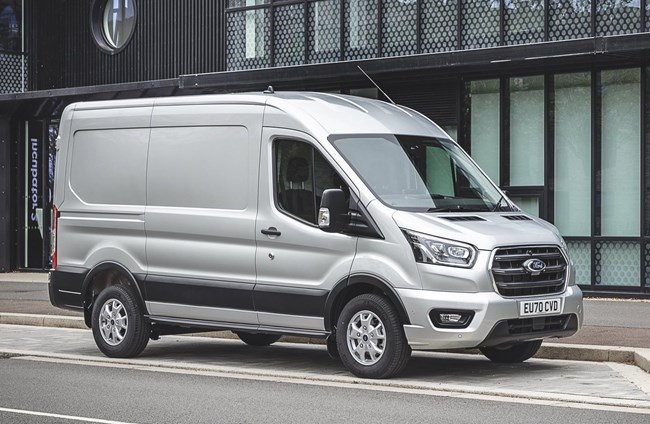- Toyota Hilux range gains new rally-inspired GR Sport II variant
- Remarketing: Pick of the bunch
- GA Commercial acquires first vans through Vanaways
- 'Luxury' tax on expensive pick-up trucks suggested
- ADVERTISEMENT FEATURE: Essential advice to avoid the van fleet ICE-berg
- ETRUX launches new Ford E-Transit Trizone
- Renault gives UK debut to Master E-Tech at CV Show
- Isuzu D-Max long-term test – Latest Report
- Isuzu D-Max V-Cross Steel Edition revealed
- IVOTY Report: Stellantis explores the hydrogen proposition
Buying a used... Ford Transit (2019)
Date: Friday, July 28, 2023 | Author: Ian Shaw
The Transit’s proliferation does not diminish its value on the used market.

For most of our readers, the Transit has simply just always been there. The German Ford Taunus Transit used the name in the 1950s, but it’s in 1965 when the story really begins. It might be part of the furniture nowadays, but the first Transit was revolutionary. The previous Thames van was old-fashioned at launch and did nothing to better the equally ancient BMC products of the day. Ford’s engineers literally designed the Transit from inside out – thinking about load and driver then designing the van around it. They obviously got it right since four generations and the same number of facelifts later brings us to this version. Launched in 2014 and updated in 2019, it is the last purely combustion-engine Transit.
Transit versions and options can run into thousands of combinations but the essentials are thus: Wheelbase lengths from 3.3–3.75 metres, giving overall lengths of 5,530mm, 5,980 and 6,700mm. Widths are 2.1–2.5 metres, mirrors in or out, and heights from 2.4 to almost 2.8 metres. It boasts load lengths of 3, 3.4 and 4.2 metres, with internal widths of 1.78 metres at maximum with a restriction to 1.4 metres between the wheel arches of single rear-wheel models and 1.15 metres on twin-wheel versions. Internal heights are 1.8–2.1 metres. Load volumes vary with each permutation but they start at 9.5m3 and top out at 15.1m3. Beyond that, you can look for Luton and high-volume bodies of which many Ford-approved versions have been developed.
Payloads naturally vary with the most increments being affected by body dimensions, drive train type and trim options. At 3.5-tonnes GVM, (there are Transits up to 4.7-tonnes that carry more) payloads range from 1,170–1,470kg. Models are designated by gross weight, hence 290, 310, 340 and 350 denoting 2.9–3.5-tonnes GVM.
So that’s the load half of the equation, what about the driver. The German makers are generally considered to head the ergonomic stakes, but the Transit has always been driver-focussed – although such millennial terms would not have been uttered in Dagenham in 1965! This fourth generation particularly, in post-2019 face lift, has an excellent driving position, great visibility, twin-element mirrors, excellent facia layout and well-considered storage in dashboard and doors. The 8in touchscreen has controls for DAB, phone or USB audio input and proper satnav, not the poor substitute of phone-mirroring. It also has an app so you can check the van is locked, for service requirements and upgrades. The seats are first-rate, comfortable and well matched to floor and step heights. Equally good for all day motorway or multi-drop city work. Steering is great, brakes too and noise levels low.
Although some 2019 Euro-6 diesels had injector problems (check the service history for rectification) the 2.0-litre unit is generally very good, in 105, 130 or 170hp guises. It is paired with either a six-speed manual or ten-speed automatic. Sounds overkill until you drive it. A gear for every occasion and fantastic mpg. Transit choice is huge, so choose least miles and best service history. Don’t bother with higher trims but look at the AWD Trail version for site work.
Five best options
1) 130hp engine
2) 170hp engine
3) 10-speed Automatic
4) L3 H3
5) Leader trim
Five best avoided
1) 105hp engine
2) Limited trim
3) Short wheelbase
4) Low roof
5) Non-approved conversions
Second-hand buys
|
Version |
Plate |
Year |
Mileage |
Price ex.VAT |
|
L2H3 Leader |
69 |
2020 |
83,500 |
£18,295 |
|
L4H3 Leader |
20 |
2020 |
77,600 |
£19,995 |
|
L3H3 Leader |
21 |
2021 |
46,000 |
£27,995 |
|
L3H3 Leader |
22 |
2022 |
12,800 |
£28,995 |
|
L3H3 Leader |
72 |
2023 |
100 |
£38,795 |
View The WhatVan Digital Edition


